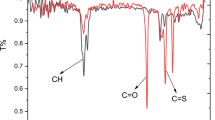Abstract
Silver nanoparticles (AgNPs) have been synthesized using maltose as reducing agent and microwave heating as reaction initiator. The nanoparticles are studied for their optical, structural, thermal, zeta potential and electrical properties. The synthesis protocol used is fast and resulted in the formation of multi-shaped AgNPs as indicated by their optical response and TEM. The crystallite size of nanoparticles and strain of the sample was found to be around 39 nm, and 2.3 × 10−1, respectively, as calculated from XRD data. Zeta potential and electrical response both showed almost threefold increase for multi-shaped as compared to isotropic nanoparticles.








Similar content being viewed by others
References
A.H. Alshehri et al., Enhanced electrical conductivity of silver nanoparticles for high frequency electronic applications. ACS Appl. Mater. Interfaces 4(12), 7007–7010 (2012)
D. Chen et al., Synthesis and electrical properties of uniform silver nanoparticles for electronic applications. J. Mater. Sci. 44(4), 1076–1081 (2009)
K.D.O. Santos et al., Synthesis and catalytic properties of silver nanoparticle-linear polyethylene imine colloidal systems. J. Phys. Chem. C 116(7), 4594–4604 (2012)
A. Panáček et al., Silver colloid nanoparticles: synthesis, characterization, and their antibacterial activity. J. Phys. Chem. B 110(33), 16248–16253 (2006)
V.K. Sharma, R.A. Yngard, Y. Lin, Silver nanoparticles: green synthesis and their antimicrobial activities. Adv. Colloid Interface Sci. 145(1–2), 83–96 (2009)
A. Troupis et al., Rate-redox-controlled size-selective synthesis of silver nanoparticles using polyoxometalates. Eur. J. Inorg. Chem. 2008(36), 5579–5586 (2008)
T. Mochochoko et al., Green synthesis of silver nanoparticles using cellulose extracted from an aquatic weed; water hyacinth. Carbohydr. Polym. 98(1), 290–294 (2013)
R. Dondi et al., Highly size- and shape-controlled synthesis of silver nanoparticles via a templated Tollens reaction. Small 8(5), 770–776 (2012)
S.V. Otari et al., Green synthesis of silver nanoparticles by microorganism using organic pollutant: its antimicrobial and catalytic application. Environ. Sci. Pollut. Res. 21(2), 1503–1513 (2014)
D. Yu, S. Xiaoquan, B. Jintian, T. Zhongcheng, Q. Yitai, Gamma-radiation synthesis, characterization and nonlinear optical properties of highly stable colloidal silver nanoparticles in suspensions. Phys. E Low-Dimens. Syst. Nanostruct. 23(1–2), 50–55 (2004)
M. Majeed Khan et al., Structural and thermal studies of silver nanoparticles and electrical transport study of their thin films. Nanoscale Res. Lett. 6(1), 1–8 (2011)
K.J. Sreeram, M. Nidhin, B.U. Nair, Microwave assisted template synthesis of silver nanoparticles. Bull. Mater. Sci. 31(7), 937–942 (2008)
Y.N. Rao et al., Gamma irradiation route to synthesis of highly re-dispersible natural polymer capped silver nanoparticles. Radiat. Phys. Chem. 79(12), 1240–1246 (2010)
K. Sivaiah, K.N. Kumar, V. Naresh, S. Buddhudu, Structural and optical properties of Li+: PVP & Ag+: PVP polymer films. Mater. Sci. Appl. 2(11), 1688–1696 (2011)
M. Venkatesham, et al., A novel green one-step synthesis of silver nanoparticles using chitosan: catalytic activity and antimicrobial studies. Appl. Nanosci. 4(1), 113–119 (2014)
Z. Zhang, B. Zhao, L. Hu, PVP protective mechanism of ultrafine silver powder synthesized by chemical reduction processes. J. Solid State Chem. 121(1), 105–110 (1996)
Z. Sui et al., An improved approach for synthesis of positively charged silver nanoparticles. Chem. Lett. 34(1), 100–101 (2005)
N. Wangoo et al., Zeta potential based colorimetric immunoassay for the direct detection of diabetic marker HbA1c using gold nanoprobes. Chem. Commun. 46(31), 5755–5757 (2010)
Acknowledgments
Authors acknowledge the financial support received from Council of Scientific and Industrial Research (CSIR) for the network project ‘BIOCERAM’, Project No. ESC-0103.
Author information
Authors and Affiliations
Corresponding author
Rights and permissions
About this article
Cite this article
Singh, S., Bharti, A. & Meena, V.K. Structural, thermal, zeta potential and electrical properties of disaccharide reduced silver nanoparticles. J Mater Sci: Mater Electron 25, 3747–3752 (2014). https://doi.org/10.1007/s10854-014-2085-x
Received:
Accepted:
Published:
Issue Date:
DOI: https://doi.org/10.1007/s10854-014-2085-x




